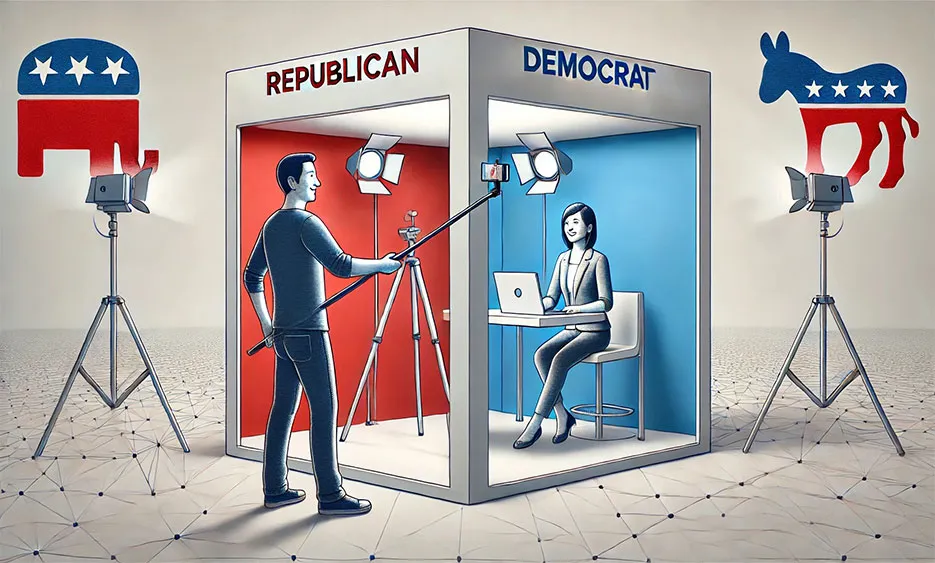
The use of social media in the 2024 US election campaign
25. October 2024
Social Media ist ein wichtiges Instrument im modernen US-Wahlkampf, und es spielt 2024 eine zentrale Rolle. Kamala Harris und Donald Trump nutzen digitale Plattformen intensiv, weil sie ihre Wähler mobilisieren und gezielt ansprechen wollen. Beide verbreiten ihre Botschaften und beeinflussen die öffentliche Meinung durch strategische Nutzung der Plattformen. Ihre Strategien unterscheiden sich jedoch sowohl in der Auswahl der Plattformen als auch in den Inhalten und der Ansprache der Zielgruppen. Beide Kampagnen setzen digitale Ressourcen unterschiedlich ein, damit sie möglichst viele Wähler erreichen und überzeugen können.
Kamala Harris: Fokus auf junge Zielgruppen und interaktive Inhalte
Kamala Harris‘ Wahlkampfteam hat eine moderne, progressive Social-Media-Strategie entwickelt, die vor allem junge Wähler anspricht. Dabei konzentriert sich die Kampagne auf Plattformen wie TikTok und Instagram, die bei jungen Menschen beliebt sind. Verschiedene Formate, darunter Memes, Kurzvideos und interaktive Inhalte, vermitteln politische Botschaften unterhaltsam und verständlich. Auffällig ist der Fokus auf Inhalte mit viralem Potenzial, die organisch eine hohe Reach erzielen können. So steigert die Kampagne ihre Botschaften, ohne ausschließlich auf bezahlte Werbung angewiesen zu sein.Ein weiterer Bestandteil der Strategie ist die Zusammenarbeit mit Influencern, die authentische, ansprechende Inhalte erstellen. Diese Influencer haben eine starke Bindung zu ihrer Community und vermitteln politische Botschaften effektiv. So erreichen sie jüngere Zielgruppen auf eine Weise, die gut ankommt. Im Vergleich zu Trump investiert Harris deutlich mehr in Werbung auf sozialen Medien. Daten aus September und Oktober 2024 zeigen, dass ihre Kampagne rund 31,5 Millionen US-Dollar in Google- und YouTube-Anzeigen investierte. Zusätzlich gibt sie wöchentlich etwa 3,5 Millionen US-Dollar für Werbung auf Meta-Plattformen wie Facebook und Instagram aus. Diese Investitionen verdeutlichen, wie wichtig digitale Kanäle für ihre Strategie sind, um Wähler in entscheidenden Swing States zu erreichen.
Donald Trump: Stärkung der eigenen Plattform und direkte Kommunikation
Donald Trumps Wahlkampfteam verfolgt einen anderen Ansatz und konzentriert sich stark auf seine eigene Plattform, Truth Social. Über Truth Social erreicht er seine Kernwählerschaft direkt und baut auf seine rund 7 Millionen Follower. So spricht er eine treue, engagierte Basis mit regelmäßigen, direkten und ungefilterten Nachrichten an. Im Gegensatz zu Harris investiert das Trump-Team weniger in bezahlte Werbung auf etablierten Plattformen wie Facebook und Instagram. Stattdessen setzen sie auf traditionelle Kommunikationskanäle, darunter E-Mail-Kampagnen und Fernsehspots.Eine bemerkenswerte Strategie ist die gezielte Nutzung von Messaging, das auf Themen abzielt, die für seine Basis wichtig sind. Dadurch gelingt es, eine direkte und unverfälschte Kommunikation zu schaffen, ohne externe Plattformen einzubeziehen. Zusätzlich nutzt das Trump-Team Social Media, um Veranstaltungen zu bewerben und Unterstützer zu mobilisieren. Besonders in wichtigen Wahlbezirken zeigt sich dieser Ansatz als effektiv, da er die direkte Kommunikation mit der Basis stärkt. So motivieren sie Anhänger, aktiv zu werden und an der Kampagne teilzunehmen.
Unterschiedliche Plattformen und Zielgruppen-Strategien
Ein zentraler Unterschied zwischen den beiden Kampagnen liegt in der Plattformwahl sowie der Ansprache ihrer Zielgruppen, denn beide setzen unterschiedliche Schwerpunkte und nutzen variierende Strategien.Kamala Harris: Vielfalt und Interaktivität
Harris’ Team setzt auf eine breite Auswahl an Plattformen und legt großen Wert auf visuelle, zugängliche Inhalte. Sie möchten besonders junge Wähler ansprechen, die häufig über Kanäle wie TikTok und Instagram erreichbar sind. Diese Strategie maximiert die Reichweite in sozialen Netzwerken und gewinnt gleichzeitig neue Wählergruppen. Durch interaktive und unterhaltsame Formate präsentieren sie politische Themen ansprechend und verständlich für ein jüngeres Publikum.Donald Trump: Fokus auf Kernwähler
Trump konzentriert sich hingegen auf seine bestehende Anhängerschaft und nutzt vor allem seine eigene Plattform. Er stärkt Truth Social und setzt auf traditionelle Kommunikationswege wie Mail und TV. So bleibt er nah an seiner Basis und verbreitet gezielte Botschaften ohne externe Filter. Diese direkte Ansprache motiviert und mobilisiert seine Wählerschaft besonders effektiv.
Challenges and risks
Obwohl beide Kampagnen ihre Strategien geschickt an die jeweiligen Zielgruppen anpassen, stehen sie dennoch vor spezifischen Herausforderungen, da sie unterschiedliche Schwerpunkte setzen und variierende Plattformen nutzen.Harris’ Herausforderung:
Die hohe Frequenz an Social-Media-Posts und die schnelle Produktion neuer Inhalte bergen Risiken, denn dadurch können Botschaften leicht missverstanden werden. Gleichzeitig bleibt weniger Raum für tiefere Diskussionen, was problematisch ist. Zudem besteht die Gefahr, dass komplexe Themen in der Flut schneller und viraler Posts untergehen. So erhält das eigentliche politische Programm möglicherweise nicht genug Aufmerksamkeit und wird vernachlässigt.Trumps Herausforderung:
Die starke Abhängigkeit von Truth Social als Hauptplattform könnte die Reichweite seiner Kampagne einschränken. Viele potenzielle Wähler bevorzugen andere soziale Medien, was es Trump erschwert, neue Wählergruppen zu erreichen. Besonders in entscheidenden Wahlbezirken, wo Meinungen noch nicht feststehen, könnte das problematisch sein.
Conclusion
Die Social-Media-Strategien von Kamala Harris und Donald Trump spiegeln ihre politischen Ansätze sowie Wahlkampfziele wider. Harris investiert gezielt in digitale Werbung und moderne Kommunikationsformen, um eine breite und junge Zielgruppe zu erreichen. Trump setzt hingegen auf bewährte Methoden direkter Kommunikation, damit er die Bindung zu seiner Basis stärkt. Beide Strategien verdeutlichen, dass der strategische Einsatz digitaler Plattformen im Wahlkampf äußerst wichtig ist. Letztlich wird sich zeigen, welcher Ansatz mehr Wähler mobilisieren und überzeugen kann.
Our blog
Latest news
With our blog, you are always close to our work, our current projects and the latest trends and developments in web and print.
Any questions?





